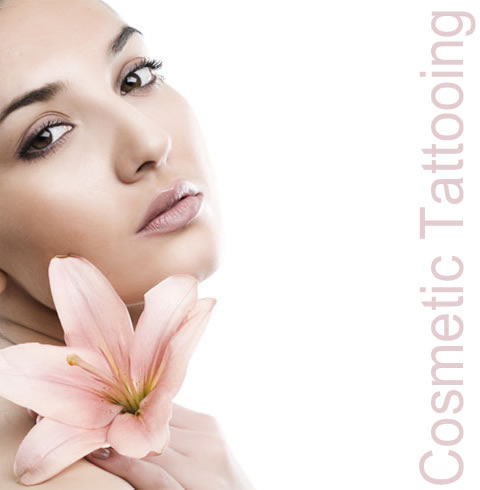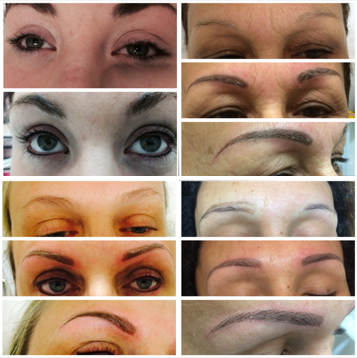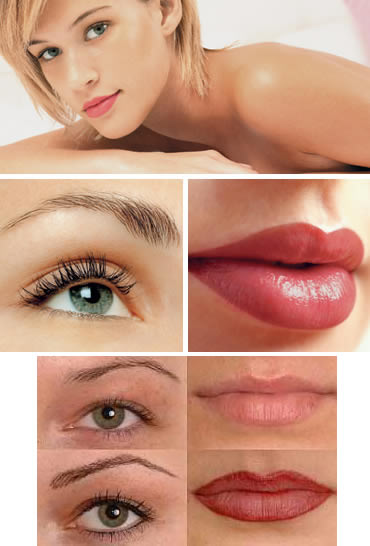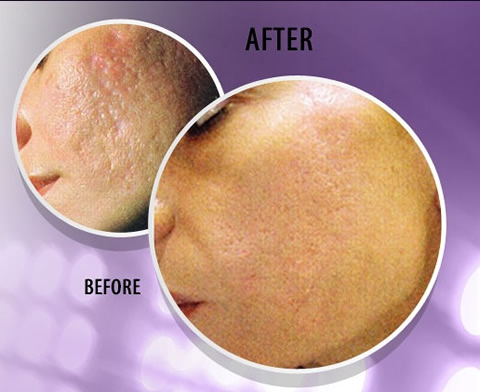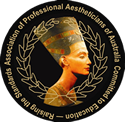Permanent makeup is not intended to replace cosmetics completely. Because the colour is placed “in” your skin and not “on” your skin, a more natural, softer look results. When you’re ready for a special occasion, you can apply as much additional makeup as you wish.
Permanent makeup is long-lasting. However, as you become accustomed to your new makeup, it’s not uncommon to want more. You may want to freshen up your new makeup every couple years. The darker the colour, such as black, the longer it will stay unchanged in your skin. More natural, delicate colours are sometimes vulnerable to the effects of sun, swimming and breakdown by the body. As a general rule, eyeliner, and lip colour have the longest longevity, approximately 2 to 5 years, depending upon the colour used. Eyebrows may not need a touch up for 1 to 3 years.
Approximately 1 to 2 hours. There will be an additional follow up procedure that will take place about three to six weeks from the day of the initial procedure.
Is Permanent Makeup Painful?
Permanent makeup procedures are semi-invasive and there may be some discomfort. It really does vary on each individual’s threshold for pain, but the sensation can be compared to tweezing. A topical anesthetic may be used to numb the areas.
What is the after care?
Brows – Do not pick, peel or force exfoliate while they are healing (usually about 7 days). Do not apply any additional makeup to the area while they are healing. Pat aftercare ointment provided on with a clean finger and splash only water on them during the healing process. You will experience 30% to 50% fading with the 1st application.
Eyes – Apply a light coat of aftercare ointment provided with a Q-tip before washing your face in the PM and wipe excess off with a damp cloth. Continue this process for 4 days. You can wear mascara on the tips of your lashes in 24 to 48 hours if you purchase a new tube, otherwise don’t wear any eye makeup for 4 days. You will experience 30% to 50% fading with the 1st application.
Lips – Immediately following the treatment there may be some swelling. This will usually last between 24 hours and 48 hours. Apply aftercare ointment provided to lips throughout the day whenever they feel dry. You will experience dryness, similar to chapped lips. Do not force peel lips when they start to peel. You will experience 30% to 70% fading with the 1st application.
What is the difference between the manual method and the machine method?
The manual method of permanent makeup is performed without the machinery and the technician provides the power behind the pen. The procedure is similar to pen and ink application. There are many different kinds of machines on the market, from traditional tattoo guns to the newer, lighter weight machines. Both techniques, if performed correctly, deposit pigment into the dermis layer of the skin and deliver the same results.
Which method do we use?
We use the Nouveau Contour digital micro-pigmentation systems. This machine use the latest in European acupuncture technology which results in less client discomfort.
Is the Treatment Safe?
The equipment used complies with all relevant health and safety requirements. All needles are disposable, sterile and of the highest quality. Sterilization and hygiene is of the utmost importance before, during, and after the treatment. All procedures are performed in a clinic
General Permanent makeup post procedure after care instructions
Cold packs have not shown to make a noticeable difference in reducing permanent makeup swelling, but they feel good on the skin and are a comfort measure. Cooling a skin wound is beneficial; freezing it is not. Using refrigerator temperature cold packs is safer for damaged dermis than freezer temperature cold packs. The traumatized tissue is already in a delicate condition and can get frost damage. Slight cooling of the skin a few times after a permanent makeup procedure can be done by applying wet tea bags, cloths, or gel compresses that were placed in the refrigerator (not freezer) in a zip lock bag. If you like to use bags of frozen peas, place a wet washcloth between your skin and the bag. Clients that leave it alone and let nature take its course heal better than the ones that frantically try to help the process. Cold packs are contraindicated for anyone with poor skin circulation, cold allergy/ cold urticaria, and other skin/ vascular/ blood disorders that react to cold temperatures.
Inappropriate/overuse use of ice packs on fragile facial skin may cause complications. The freezing can cause ice crystals to form in the skin cells and damage them. Additional swelling can rush in after removal of the ice pack as skin warms. In short, your efforts to reduce swelling with repeat freeze-warm cycles can have the opposite effect and increase swelling. The ice pack initiates primary constriction of blood vessels, then in response, vessels dilate and the area swells (reactive hyperemia of skin microcirculation). Oxygen is needed to heal wounds. Prolonged application of extreme cold reduces the blood flow that brings oxygen to the skin cells and may cause wound hypoxia and acidosis. A certain amount of skin perfusion pressure (SPP) is needed to maintain transcutaneous oxygen tension (TcPO2) for healing. Hypothermia increases risk of infection by reducing tissue oxygenation in hypoperfused tissues. Oxidative killing by neutrophils is a defense against pathogens, and rate of bacterial killing depends on sufficient tissue oxygenation.
| * |
A permanent makeup procedure is the equivalent of a skin-deep wound - like a scratch you might get around the house. Expect it to ooze a little, scab a little, and heal in a similar time frame. |
| * |
May cool the skin a few times after permanent makeup procedure with cold pack (or wet and chill chamomile tea bags) for 10 min. every couple of hours the first day. Don’t overdo it. May switch to warm moist pack (or tea bags) after the second day. |
| * |
Keep moist with healing ointment at all times while outer healing occurs (3-5 days eyes, 7-10 days lips). Recommendation: vitamin A,D ointment |
Specifics For LIPS
| * |
Lips will ooze a couple of days. Blot and reapply ointment. After sleeping, crust will have dried on the lips. Rinse with water or put more ointment on to loosen crust, blot and reapply ointment. Most tissues like the ones you blow your nose with will leave lint on the lips. Use something stronger and lint-free like Bounty hand towels. A soaking wet cloth feels good to blot with. |
| * |
Lips will be tender at first. Drink through a straw. Choose foods you can place in your mouth with a fork without touching lips.
|
| * |
Place an old towel on the pillow you will sleep on until the oozing stops so you won’t ruin good pillowcases or pillows. |
| * |
Do not excessively stretch lips while they are healing with big smiles, or pucker lips with smoking. Those motions push and pull against the lip edges, applying tension and friction between the strong normal skin surrounding the mouth and the broken inflamed lip edges. Lip skin is a continuation of the delicate mucous membrane in the mouth. It is not strong like normal skin.
|
| * |
On the third day, lips stop oozing and start peeling. This is when the chapped lip feeling is strongest. You may relieve the chapped lip feeling by lightly massaging the lips after placing a thick layer of ointment on them and making gentle circular motions with one finger. The light, wet massage helps get loose skin off that is ready to come off without yanking out skin that is not ready to come off. The massage relieves the chapped feeling for several hours, then it returns, and you can massage again.
|
| * |
Lips will peel for a week. Other than the massage mentioned above, allow it to flake off on its own. Picking and pulling off skin that is not ready to come off will cause pigment loss and can pull out deeper tissue. The edges or lip liner will be the last to fall off. Pulling this off will result in an uneven splotchy line or an indented scar (like messing with a pimple).
|
| * |
Try to keep toothpaste off lips while healing. |
| * |
Do not have teeth bleached while healing.
|
| * |
During the peeling process it may look like there is not much colour there. Colour is more apparent by the second week. Final result is not judged for 2 months. |
| * |
It is normal to have discomfort or a feeling of pressure the day of the lip procedure. If you begin having pain on the 3rd or 4th day after being pain-free, it is a signal that something is wrong. It is usually one of three things: 1) Infection, 2) Cold sore, or 3) Allergic contact dermatitis from antibiotic ointment. Switch ointments to rule out that as the cause, and consider a culture to determine bacterial vs yeast infection. |
| * |
Lip infections after permanent makeup procedures are usually described as burning pain. Bacterial lip infections have a yellow gooey discharge, but begin peeling as expected on day three. Candidal lip infections do not begin peeling on time as would be expected with healthy healing lips (possibly due to candida adhesion properties), and may have a velvety appearance. Candida lip infections have one or more of the following depending on the strain or severity of the infection: cracking and bleeding – more likely near the corners, itching or tingling, whitish bumps/ nodules/ blisters/ pustules – more likely along the edges of the lips. Fungi concentration has been more prominent on the periphery of healing lips where they do the most damage causing blisters, scarring, or tightness. The tightness may relax in time but can take months to years.
|
| * |
Lip skin yeast cultures taken before the lips heal over usually return positive results in individuals fitting yeast symptoms. Lip skin yeast cultures taken after the lips heal over may return false negative results. Being past the point of reliable results for skin swab culture, a person might need to speak with a dermatologist about a biopsy for diagnosis. Candida strains have a tricky ‘switching’ ability to change phenotype and display various colonial morphology and physiological properties to invade and survive in various environments/ tissue types or body areas, which might account for some of the false negative testing results. Candida should be given the last name chameleon. Candida antibiotics started early (within the first week) clear up lip infections well. Delayed therapy can allow the organism to penetrate deeper tissues, and the person may experience a lengthy spell of sore lips, and be able to feel knots deep in the lip tissue.
|
| * |
After the lips are healed over and all is well, they still feel more chapped than normal. The chapped feeling subsides over a period of weeks to months. Certain lip balms create the problem. Do not use anything made for cold sores or blisters (carmex, blistex) because although they initially feel moisturizing, they turn around and dry the lips out. Some do more damage than that, especially if applied on broken lip tissue during the healing process. Applying vitamin E will usually help.
|
Healing Time
Permanent makeup will appear extremely intense and thick immediately after the procedure. The colour will not even look right the first few days. Other factors are added to the permanent makeup pigment bottles to counteract the undertones of facial skin. Browns can look orangish-brown, blonde brows may look too yellow, lip colours are shocking! Some colours initially look too bright and others look too dark. But don't worry - it changes. Excess pigment sheds off over the next 2-3 days, and then the skin starts healing over. A layer of healed skin on top of the pigment masks and tones it down considerably. As swelling goes down the lines will be thinner. On about the fourth day you are close to looking normal and no one notices anything. Colours will continue to soften over the next few weeks. It will look very natural in 2-3 months. You see another difference around the 7-9 month time period. It looks even softer and lighter. Brows and lips that looked fine at 2-3 months may have faint areas or be too light after 7-9 months.
OUTER HEALING completes in about 3-6 days for eyes, 7-10 days for lips. INNER HEALING completes in 1-2 months.
Swelling migrates as it resolves. Dispersion into a larger area aids dissipation of swelling. In addition to on-the-spot absorption of swelling by the lymphatic system, excess fluid travels down with gravity through the fatty tissue. If you have watched someone heal from a bruised eye, you noticed that by the time it is almost healed the last little bit of swelling and discoloration is an inch or two lower at the cheekbone.
Swelling from eyebrows can drain to the top eyelids. Swelling in top eyelids have a little movement out and down from the sides over the outer half, but fluid over the inner half is mostly trapped there until absorbed. Swelling in the bottom eyelid drains down to the cheekbone. Swelling drains out of the bottom lip faster than in the top lip. Fluid from the bottom lip can drain down the chin and neck to speed removal. Since the top lip doesn’t have anywhere to drain below it, other than a little movement out to the sides, fluid is stuck there until the lymph system can suck it all out.
How easily a person swells and bruises may be affected by age, food and meds consumed, and hormonal cycles. Brows have minimal swelling, but the wet paint look is difficult to hide unless you have long bangs or big rim sunglasses. Eyes have moderate swelling, but can be easily hidden with sunglasses. Generally speaking, younger women’s eyes swell less and the swelling goes down faster after eyeliner procedures. Older women have loose skin that provides a greater water holding pocket. Additionally, circulation and cellular turnover slows with aging. Lips can swell four times their normal size, and there is no hiding them. Request a few surgical masks if you are embarrassed to walk out of the building, or for use at home in case you have to answer the door, or make a trip to the store. After three or four days when the area is healed enough that you don’t have to worry about infection, you can mask the area with other makeup/ powder/ lipstick while waiting for healing to complete.
How quickly a client returns to work depends on which permanent makeup procedure she had performed, and what type of occupation she has (greets the public, or works more privately in office). Eyes and brows are a breeze. Clients have eyes and brows done on Friday or Saturday and return to work Monday. Lips are a bigger ordeal. Clients usually have lips done on Thursday or Friday and return to work on Wednesday or next Thursday.
Skin Needling
I’ve never heard of skin needling? Is this a new procedure?
Susan Church CCPC, pioneered skin needling in 1990. More recently, prominent South African Plastic Surgeon, Dr. Des Fernandes delivered a paper about his results with skin needling, which showed improved collagen production, scarring, texture and ageing. The paper “Percutaneous Collagen Induction Therapy: an Alternative Treament for Scars, Wrinkles and Skin Elasticity,” was published in Journal of Plastic Reconstructive Surgery in 2008 and, in a study of 480 patients, showed significant effectiveness of “skin needling” in treating wrinkles and scars without the tissue damage and scarring frequently observed with laser treatments and chemical peels.
How does skin needling compare to laser treatments?
Needling stimulates the effects of those from laser resurfacing, but without the harsh damage to the epidermis. It is also much more economical.
When performed by a professional, is much more effective since the technician can target the specific areas.
Is skin needling an alternative to collagen fillers?
Yes, skin needling is a natural alternative to synthetic collagen fillers. To look your best, we recommend clients consider having anti - wrinkles injection to paralyze their muscles and therefore enhance the skin needling results.
What kind of recovery can I expect from skin needling?
The area should not be exposed to the sun, tanning bed, heat, hot water or sauna for 5-7 days. It is extremely important to protect your skin with at least SPF 30 at all times. The skin will appear to have red ‘cat scratches’ for a few days following each session. Mineral makeup can be worn the day after the needling application. The treated areas should be kept moist with A& D or like product 3-7+ days post treatment or until the scabs fall off.
What kind of results can I expect from skin needling?
Most people see results within the first few days of each treatment and continue to see results up to 3 months post treatment. Results can last for years. Individual results vary as each body’s regeneration is unique. The daily use of topical products such as; Retinol (Vitamin A), Vitamins C & E and/or 25% Hyaluronic Facial Enhancer will help boost collagen and regenerate the tissue after each needling session.
Is there a certain type of scar it won’t work on?
It won’t work on keloids, dark or red scars. Also, the scar must be a minimum of 6 months old.
How many sessions are needed for skin needling, scar relaxation and/or melanocyte restoration?
The treatment usually requires 1-3 sessions in 4-6 week intervals.
Is it painful?
The procedures are semi-invasive. A topical anesthetic is applied to the area prior to the treatment. Most clients feel very little discomfort, if any at all
Call now to arrange your appointment or if you have any further questions book a obligation free consultation on:
0434 799 096


